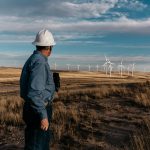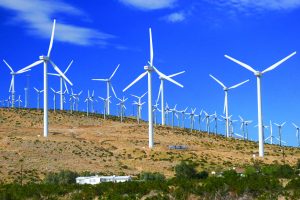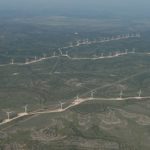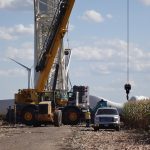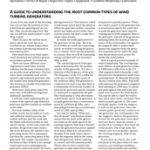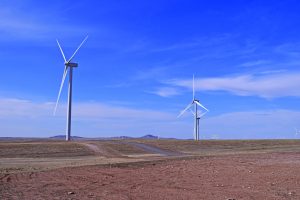The numbers are in — America’s top renewable energy resource continues to grow, fostering economic development and delivering clean, low-cost energy across the country. Just as important, all the data indicate we can expect this growth to continue in the years ahead.
AWEA’s U.S. Wind Industry Annual Market Report, Year Ending 2016, released in April, provides a complete picture of industry activity last year. Let’s dig into the numbers and review the highlights.
They paint a clear picture: Wind works for America.
A lot of New Wind, More in Pipeline
American wind power now exceeds 82,000 MW of installed generating capacity, enough to power 24 million typical U.S. homes. That places it ahead of conventional hydropower as the country’s largest source of renewable generating capacity and the fourth largest source of electric capacity overall.
This development spans the nation. Down south, North Carolina became the 41st state with a utility-scale wind farm early in 2017, while projects began operating throughout the Midwest and Plains states and even as far away as Guam.

More than 8,200 MW of new wind capacity came online in 2016, with significant amounts still to come. More than 18,000 MW remain under construction or in advanced development. Once online, these projects will provide enough new wind energy to power millions of additional American homes.
All of this new development means wind provides a growing share of our electricity mix. Wind supplied 5.5 percent of the country’s electricity in 2016, and remains on track to supply 10 percent of America’s electricity by 2020 — a goal set in the Department of Energy’s Wind Vision.
At the state level, results look even more impressive. Iowa led the way by generating more than 36 percent of its electricity using wind, while South Dakota also topped 30 percent. North Dakota, Oklahoma, and Kansas all generated more than 20 percent of their electricity from wind turbines. Overall, wind produced more than 10 percent of the electricity in 14 states.
Wind Growth Equals Job Growth
The U.S. wind industry also continued its role as a major job creator in 2016 — wind-related jobs total 102,500 and can be found in all 50 states.
More than 25,000 of these positions are manufacturing jobs at more than 500 U.S. factories that build wind-related parts and materials. This provides an important boost to a sector of the U.S. economy that has struggled for decades, and it helps bring new jobs to the places that need help the most, like the Rust Belt.
For example, Ohio leads the country with 62 wind factories, while Wisconsin and Pennsylvania have 26 each, and Michigan has 25. And while the Southeast has historically lagged in wind-farm installation, the region has a strong wind-manufacturing base, with more than 100 factories building components destined for wind turbines.
U.S. wind manufacturing will continue to grow. Wind-related manufacturing jobs could top 33,000 by 2020, according to Navigant Consulting — a gain of 8,000 new factory jobs by the end of President Donald J. Trump’s first term.
Wind energy also brings jobs to rural America, another area that needs new opportunities.
Wind-turbine technician is by far the country’s fastest growing job, according to the U.S. Bureau of Labor Statistics. Because 99 percent of wind farms are built in rural areas, wind-tech positions offer new jobs in places traditionally short on options. With the U.S. wind fleet now topping 52,000 turbines, with more coming in the years ahead, demand is surging for operations and maintenance jobs.
Importantly, the U.S. wind industry proudly offers good jobs to the men and women who serve our country — veterans find wind jobs at a rate 50 percent above the average industry, based on data from the Department of Energy.
Wind-related jobs should continue booming over the next four years and could near a quarter of a million by 2020, according to Navigant Consulting. A deeper analysis of Navigant’s report also finds manufacturing and installing each new turbine supports 18 full-time jobs.

Unmatched Investment in Rural America
The economic benefits of wind power extend far beyond job creation, however. Wind brings investment into rural America like few other industries.
“Wind energy, the fastest-growing source of electricity in the U.S., is transforming low-income rural areas in ways not seen since the federal government gave land to homesteaders 150 years ago,” the Omaha World-Herald recently reported. “As commodity prices threaten to reach decade lows and farmers struggle to meet debt payments, wind has saved family farms across a wide swath of the heartland.”
Wind power does this by offering the country’s farmers and ranchers a new drought-proof cash crop — landowners hosting turbines received at least $245 million in lease payments last year. They can count on that income, which helps a lot in the thin-margin agricultural business. It offers stability in times of drought or less-than-ideal market conditions. For many families, wind-lease payments make the difference between continuing a multi-generational tradition and ending a way of life.
“We weren’t making enough money to sustain ourselves,” Richard Wilson, a Colorado rancher, recently told Bloomberg Businessweek. “Now we’re in a position where we can operate our farm for another generation at least.”
However, wind-turbine landlords aren’t the only beneficiaries. Wind farms often pay the largest share of a county’s taxes, substantially boosting local revenue. That adds new resources to county budgets, needed to pay teacher salaries, repair roads, or buy new snowplows. New wind projects will pay $8 billion in taxes over the next four years, on top of tax revenue from existing projects, according to Navigant.
Overall, wind is expected to drive $85 billion of domestic economic activity through 2020.
Utilities and Fortune 500’s Drive Demand
Both utilities and non-traditional purchasers like Fortune 500 companies continue to drive new demand for wind.
America’s large electric utilities have indicated they plan to continue adding more renewable energy to their electricity mixes. In April, PacifiCorp announced plans to add substantial new wind generation, upgrade its existing wind fleet, and build new transmission to open access to more wind energy.
“These investments will significantly increase the amount of clean renewable energy serving customers and reduce costs at the same time,” said Stefan Bird, president and CEO of Pacific Power, the unit of PacifiCorp that serves customers in Oregon, Washington, and California. “This is a win-win and represents our continued commitment to both reduce the environmental impact of the energy we produce and keep costs low.”
In 2016, both MidAmerican Energy and Alliant Energy committed to billion-dollar investments in new wind projects. Meanwhile, Xcel
Energy announced plans to develop new wind projects in seven states, including Minnesota, Colorado, New Mexico, and South Dakota.

“We’re investing big in wind because of the tremendous economic value it brings to our customers,” said Ben Fowke, Xcel’s chairman, president, and CEO. “With wind energy at historic low prices, we can secure savings that will benefit customers now and for decades to come.”
Large corporations also want to make more of their products using wind power.
Google expects to run all of its worldwide operations using renewable energy in 2017, sourcing 95 percent of that electricity from wind.
Earlier this year, Home Depot purchased enough wind for 100 of its Texas stores. GM bought enough wind power to run 100 percent of an Arlington, Texas, factory where the company builds 125,000 SUVs a year. And Amazon has agreements to run data centers in four states using wind energy.
“This pursuit of renewable energy benefits our customers and communities through cleaner air while strengthening our business through lower and more stable energy costs,” said GM CEO Mary Barra, speaking about her company’s pledge to transition to 100 percent renewable energy.
Both utilities and Fortune 500 companies remain enthusiastic about adding wind power because, in many parts of the country, wind beats all other generation sources on cost, and it’s cost-competitive in many more. In fact, today wind costs 66 percent less than just seven years ago. Technological advances spurred by American innovation played an important role in this decline, allowing wind turbines to reach stronger, steadier winds, making more electricity more of the time.
Wind power remains on track to supply 10 percent of America’s electricity. It creates new jobs and invests in the communities that need help the most. And many of the world’s most successful businesses turn to wind as a solution for their energy needs. That offers plenty of proof that wind works for America.

















